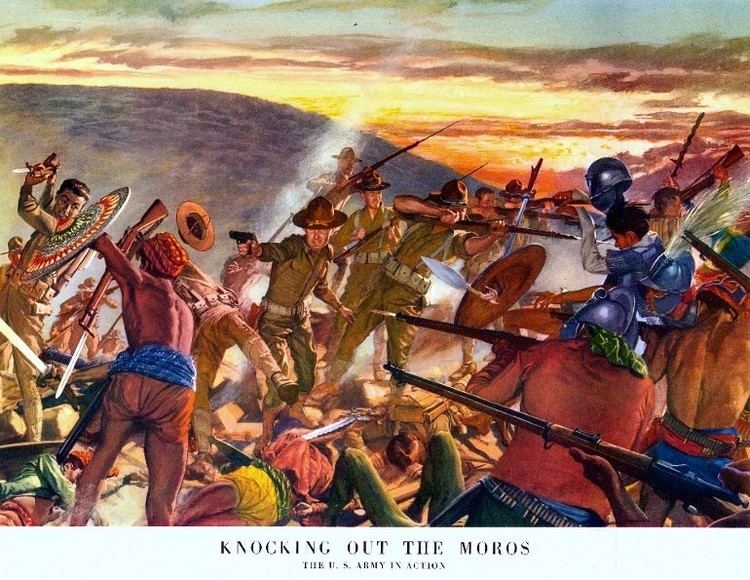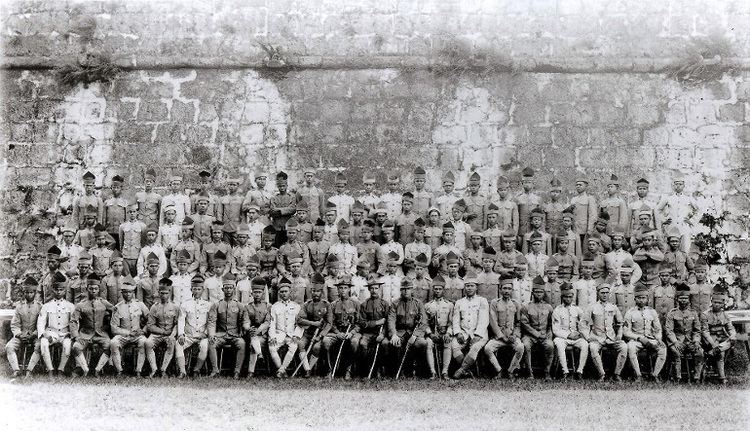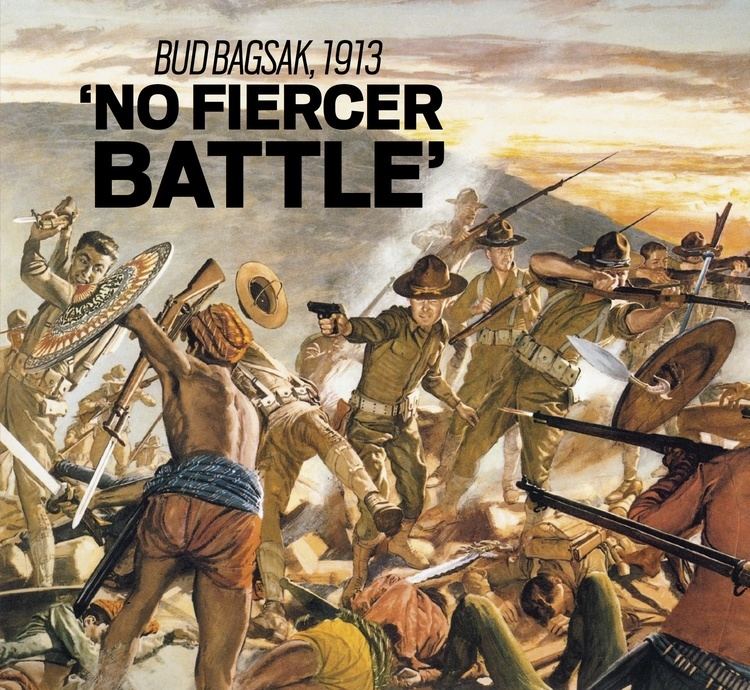200-500 including women and children 14 killed25 wounded Result American Victory | Dates 11 Jun 1913 – 15 Jun 1913 | |
 | ||
Similar First Battle of Bud Dajo, Moro Rebellion, Balangiga massacre, Battle of Paete, Battle of Mabitac | ||
The Battle of Bud Bagsak was a battle during the Moro Rebellion phase of the Philippine–American War fought between June 11 and June 15, 1913. The defending Moro resistance fighters were fortified at the top of Mount Bagsak on the island of Jolo, Sulu. The attacking Americans were led by General John 'Black Jack' Pershing. The Moros were entirely annihilated, including their leader, Datu Amil.
Contents

Moro Rebellion
Background

In March 1913, Datu Amil and 1,500 warriors negotiated with the Sultan of Sulu and other Moros allied with the Americans, pledging to surrender their weapons. Two months later, having retreated to Bud Bagsak with his entire population of 6,000-10,000 in the Lati Ward, he told the Americans to "come on and fight".

Noticing the Moros only fled to Bud Bagsak when provoked by government troops, General John J. Pershing devised a policy of keeping the troops in their island garrisons in the hopes the women and children would come down from the mountain cottas. At the same time, Pershing secretly landed his force at the coastal town of Bun Bun, three and a half miles from Bud Bagsak. Pershing's force consisted of the 51st and 52nd Companies of Moro Scouts from Basilan and Siasi, besides the Philippine Scouts from Jolo and fifty troopers from the 8th Cavalry Regiment.

The horseshoe-shaped volcanic crater, open on the northwest at a knoll called Languasan, was protected by five cottas, Bunga, Bagsak, Puhagan, Matunkup and Puyacabao, ranging from 1,440 to 1,900 feet in elevation.
Colt .45 pistol

In many other battles in the Morolands, the U.S. Army Colt .45 caliber pistol was tested and perfected as an effective "man stopper" against the Moro fighters, who often fought with berserker tendencies.
But the use of the .45 Colt Automatic in Bud Bagsak is still subject to debate since the first shipment of the .45 Colt Automatic pistols for the Philippines were still in crates in the harbor of New York in the early months of 1913, and the actual date of the arrival of the pistols in the Philippine Islands needs to be verified by researching the ship used to transport the pistols, the date it departed the Port of New York and its arrival in the Port of Manila as well as any and all existing shipping records, up to the moment the pistols were issued to the soldiers. Since no photographic evidence actually exists of an American soldier carrying a .45 Colt Automatic pistol in Bud Bagsak, and unless it is proven that the .45 Colt Automatic pistols were in the hands of the Americans in Bud Bagsak prior to June 1913, the use of the .45 Colt Automatic in Bud Bagsak remains subject to debate.
The real "man stopper" used against the "juramentados" or "berserker" Moros may very well have been the Winchester Model 1897 shotgun. This was issued to soldiers in Bud Bagsak.
Battle
Pershing made Languasan his first objective as a place for his artillery and to block any escape, sending Major George C. Shaw with Company M of the 8th Infantry and the 40th Company of Philippine Scouts. Pershing also sent Capt. George Charlton and his 51st Moros to attack Matunkup while Capt. Taylor Nichols' Philippine Scouts attacked Puyacabao. By 12:20 PM, Matunkup was in American hands, and earned 2nd Lt. Louis Mosher a Medal of Honor. Puyacabao fell by 12:30 PM. That ended the first day of fighting, 11 June.
Early on the morning of 12 June, the American artillery fired on Puhagan while marksmen fired on its interior, killing Datu Amil. Pershing then ordered Capt. Patrick Moylan to attack Bunga with the 24th and 31st Scouts, taking it by 1:30 PM. Pershing, James Lawton Collins, and a ten-man escort scouted Bagsak, which convinced Pershing to bring up his artillery on 14 June and attack from the south.
The offensive commenced on a foggy Sunday morning, 15 June, utilizing mountain howitzers, with Charlton's Moro forces advancing at 9 AM. As the attack encountered resistance, Pershing, alongside other American officers, positioned themselves at the vanguard, playing a crucial role in thwarting a Moro counteroffensive. The decisive attack on the cotta took place at 5 PM, resulting in the capture of Bagsak following a three-and-a-half-hour battle.
Aftermath
General Pershing in a letter to his wife, he wrote: "The fighting was the fiercest I have ever seen. They are absolutely fearless, and once committed to combat they count death as a mere incident."
